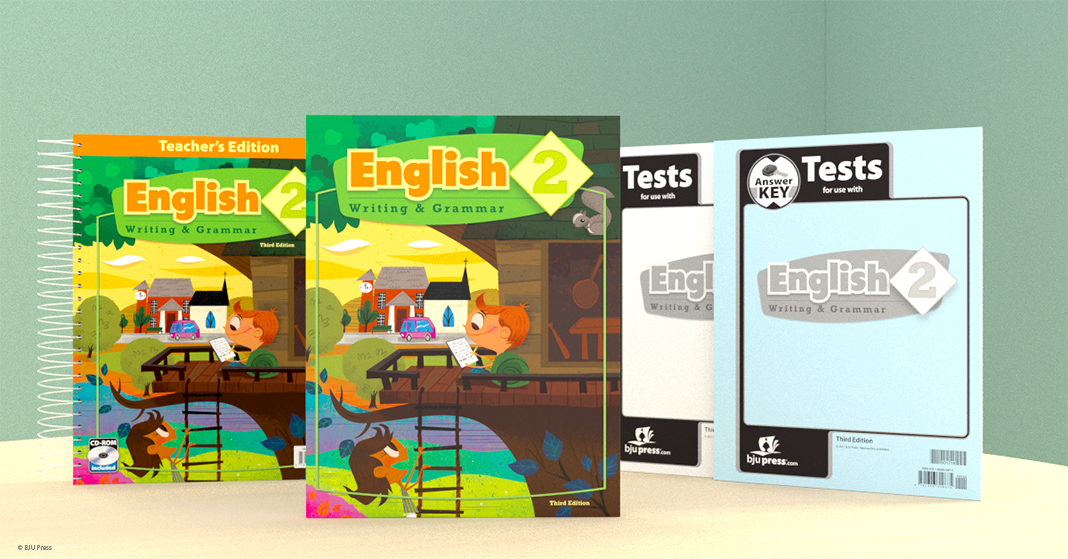
Writing has always been one of my favorite things to do. My mother would transcribe oral stories I retold as a preschooler. (It’s true! You can read about it here.) Then when I was in the elementary grades, we would “publish” a book each year as a compilation of all my homeschool writing projects. I loved sharing my stories, haikus, and book reports with adults. It made me feel important when they would comment on my work.
Now when I learn about a new language arts textbook that teaches children why writing is valuable and shows them how to do it successfully, I get pretty excited! The new edition of English 2 is one such textbook. It brings together both the writing and grammar elements that your child needs to be an effective communicator for God’s glory. Included in the English 2 Subject Kit are the following pieces.
Student Worktext
The strength of this student worktext is in its alternating chapters of grammar and writing instruction. You can read more about how the BJU Press elementary English curriculum builds a solid foundation with this approach. There’s also a strong biblical worldview connection between understanding what God communicates through language and how your child can use this gift to serve God and love others.
It appeals to visual learners with the cheerful colors, consistent icons, and engaging activities that prompt critical thinking. The illustrations are done by some of my favorite in-house artists and capture interest on each page.
The student worktext also provides hands-on learners with writing project examples to use as models and grammar exercise pages to practice new skills.
You can get a more detailed look at the grammar and writing chapters when you watch my English 2 walkthrough video.
Grammar focus: These chapters develop critical thinking skills as new concepts are introduced and applied in exercises. Each chapter follows the same model: learn, apply, and review. Also included are journal pages where your child has the opportunity to do some free writing without the constraints of a specific project and without receiving a grade.
Writing projects: These chapters come in between the grammar ones so that your child is prepared to use correct grammar needed for his projects. We introduce literature links to some published works as real-life examples. The five-step writing process and sample writings provide a framework to follow so that your child knows the step-by-step process for completing his goal—whether it’s a poem, personal narrative, letter, or research report.
Teacher’s Edition
This book takes your child’s learning to another level while simplifying your life at the same time! It shows materials needed for each lesson, provides questions and prompts to engage your child, and gives you all the answers for each student worktext page in one easy-to-find location—right within the reduced student pages for the corresponding lesson. View the teaching resources and Chapter 1 of the English 2 Teacher’s Edition.
Tests and Answer Keys
These two pieces provide the assessments your child takes to gauge his understanding of the concepts being taught as well as the correct answers for you to measure your child’s comprehension. They also offer you suggestions for grading.
Explore all the BJU Press English and Writing & Grammar subject kits on our website.
Look at her go! Thanks for sharing, Tricia. The only thing that got me excited about math at her age was using manipulatives of shapes and paper money as well as baking in the kitchen with my mom. Maybe your daughter would enjoy similar hands-on activities.
My daughter was a great writer… until she actually had to write things down for herself. Suddenly, everything turned into the shortest sentences possible. One week into 2nd grade with this new edition and I’m already seeing improvement in her writing. The grammar pages include a section where the student is creating the answer, from filling in a blank to writing a sentence. There isn’t a word bank, though it is suggested we create one together. My daughter is using the dictionary from the back of the book and expanding the length of her sentences. One page asked for a sentence, then wanted the student to circle the action part. I gave her a bonus point when her compound answer had both action parts circled, without any prompting on my part. Now to get her this excited about math…